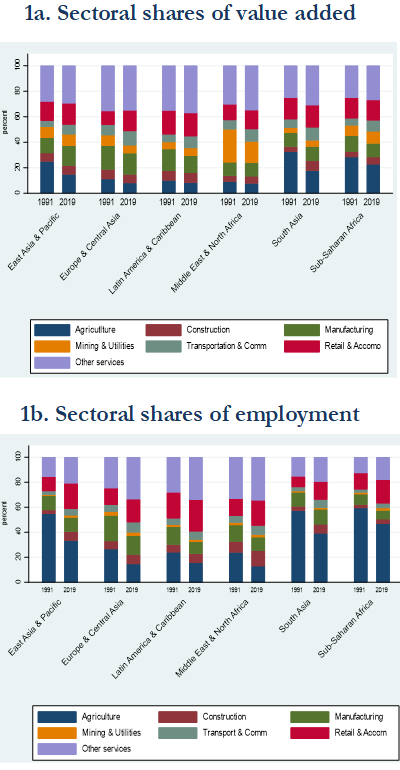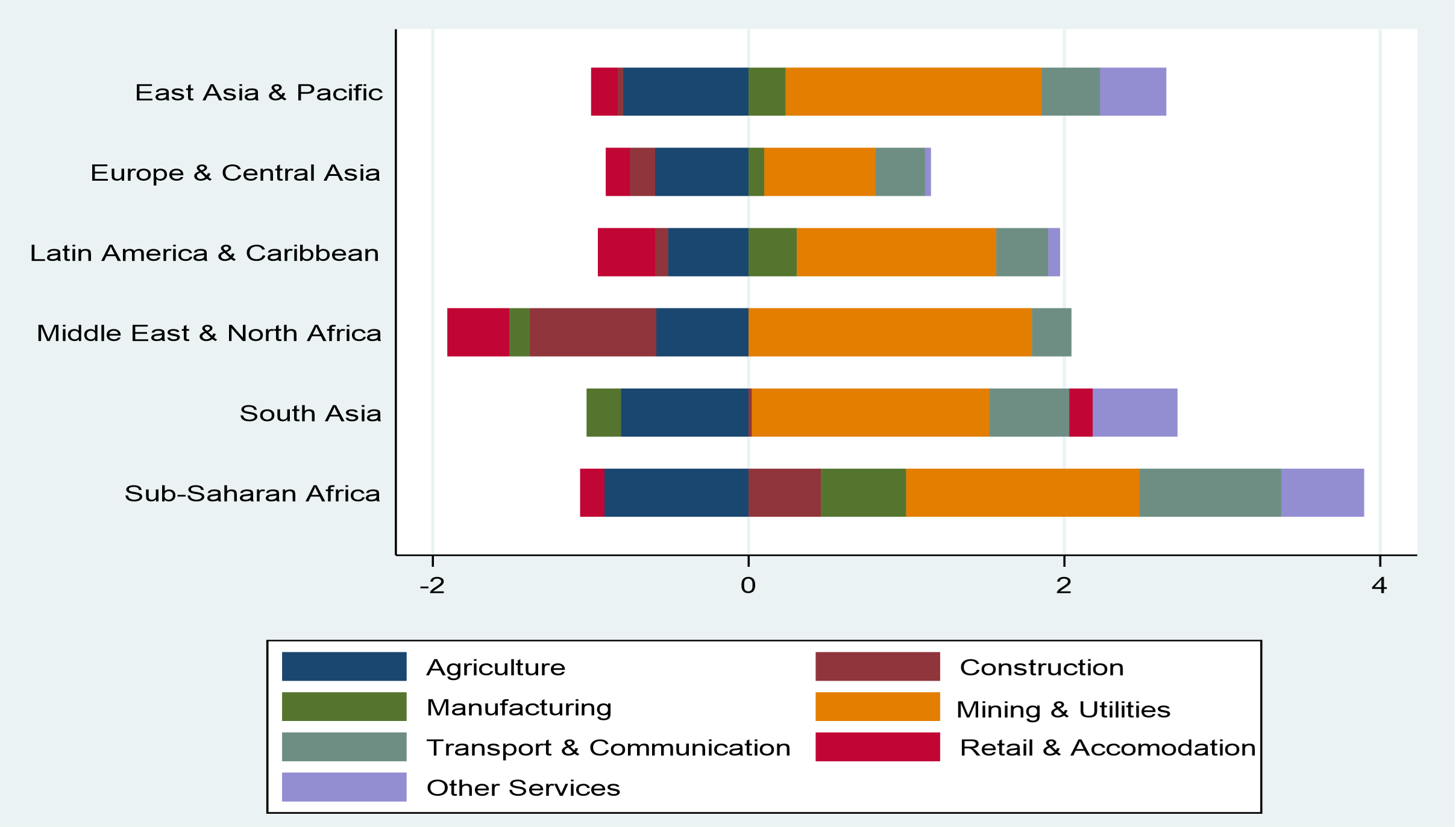by Mohamed Ali Marouaoni[*], Jala Youssef[†] and Chahir Zaki[‡]
Not all developing countries were able to achieve structural change and successful transformation experiences remain confined to some countries (mainly Asian ones). As this article explains, there is still no consensus on underlying supportive policies for structural change in developing countries. Our findings show that structural policies improve structural change over the long run, yet their effect is mostly insignificant over the short run. Our results also point to deindustrialization trends since structural policies exert a positive and significant effect on services share in value added whereas their effect on manufacturing share is either insignificant or negative. As per macroeconomic policies, our results highlight the importance of countercyclical fiscal policies and undervalued currencies in enhancing structural change.
Introduction
Structural change tends to occur when resources from traditional and typically low productive activities shift to modern and more productive ones, with higher productivity growth (McMillan et al., 2016). Countries that have experienced such growth-enhancing productivity were more likely to witness sustained economic growth and economic development (Lopes et al., 2017). However, not all developing countries were able to achieve structural change. For instance, some Asian countries have experienced a successful structural change whereas the pace of the latter in other developing countries was slow which explain their prolonged periods of low and volatile economic growth (Diao et al., 2017). In this context, it is important to identify the drivers of successful structural change in developing countries.
There is still no consensus on underlying supportive policies for structural change in developing countries. Two types of policies can be considered to promote the movement of resources from low to high productive sectors. On the one hand, developing countries can adopt a developmental approach for macroeconomic stabilization policies to make them induce structural change. This entails going beyond the conventional concept of macroeconomic stability and undertaking countercyclical policies that help facing challenges related to external financing and fluctuations in commodity prices (Ocampo, 2011). On the other hand, structural policies can be adopted in order to correct market failures, improve inter and intra sectoral allocative efficiency (Kouamé and Tapsoba, 2019; Solow, 2004) and address shortcomings related to structural rigidities in the economy.
In this context, we attempt to distinguish between the impact of structural and macroeconomic policies on structural change in both the short and long runs. Indeed, while structural policies tend to induce higher growth and productivity as well as better allocative efficiency in the long-term, their short run gains remain uncertain. The latter often hinged on business cycle or initial conditions. These gains are also slow to materialize and face policy implementation hurdles that entail short run costs (IMF, 2019; Hollweg et al., 2014). We show that the within-sector productivity improvements have been the main driver of productivity growth in East Asia and Sub-Saharan Africa. Furthermore, structural change has been growth reducing in Middle East and North Africa (MENA) and Latin America. More specifically, structural policies improve structural change over the long run, yet their effect is mostly insignificant over the short run. Our results also point to deindustrialization trends since structural policies exert a positive and significant effect on services share in value added whereas their effect on manufacturing share is either insignificant or negative. As per macroeconomic policies, our results highlight the importance of countercyclical fiscal policies and undervalued currencies in enhancing structural change.
Patterns of structural change in developing countries
Sectoral value added and employment are the most common production related measures of structural transformation (Herrendorf et al., 2014). Figure 1 depicts average sectoral shares of real value added and employment in our group of developing countries (low- and middle-income countries in 1991 and 2019). The following conclusions can be drawn. First, structural transformation pace differs across regions. Yet, all regions witnessed resources reallocation away from agriculture and its share in value added and employment declined. With the development process, workers migrate to cities to find opportunities in the industry or services sectors instead of agriculture (Bustos et al., 2016). Second, the value-added share of agriculture is considerably lower than its respective employment share in all developing regions leading to a low level of productivity compared to developed countries. (Herrendof et al., 2014; Caselli, 2005). Third, the typical structural change path entails a reallocation from agriculture to industry and subsequently to services. Yet, some developing countries followed a different path with a shift from agriculture directly to services without witnessing much industrialization. This seems to be the case in most regions where industry share in employment and value added remained somehow unchanged, despite the decline in the respective shares in agriculture. Structural change path of developing countries, with this leap of industrialization or manufacturing phase and whether services can substitute manufacturing, is debatable. On the one hand, manufacturing can be essential for inducing further structural change given its increasing returns to scale, tradability and linkages with agriculture and services. On the other hand, services still induce structural change, especially those related to innovation and knowledge (Martins, 2019).
Figure 1: Sectoral shares of employment and value added in developing countries, 1991-2019 (percent, averages by region)

Source: Authors’ calculations based on UN Statistics National Accounts data and ILO data
Ideally, the labor moving out of agriculture should be directed to sectors with productivity levels above the average. Sectors with rising employment shares are expected to be those with a relative labor productivity above zero. This does not seem to be the case in several regions (Figure 2). Labor moved to the retail and accommodation sector in all regions, while the sector has a lower productivity level than the economy wide average. The same applies to the construction sector in East Asia, MENA and South Asia. In addition, labor moved to “Other services”, yet this sector productivity level is only marginally higher than the economy wide average (especially in Europe and Latin America).
Figure 2: Relative sectoral labor productivity (2019)

Source: Authors’ calculations based on UN Statistics National Accounts and ILO data
Note: Relative sectoral labor productivity is calculated as the logarithm base 10 of the ratio of sectoral productivity to the economy wide productivity (Martins, 2019). If the bar measures 1, then the sector’s productivity is 10 times higher than the average (economy wide productivity). If the bar measures -1, then the sector’s productivity is a tenth of the average.
In order to examine the structural change patterns, a productivity growth decomposition exercise is undertaken following McMillan et al. (2014) and McMillan and Rodrik (2011) methodology. Figure 3 reveals the following conclusions on the reallocation process in different regions. The figure refers to three periods on average: 1991-2000, 2001-2010, 2011-2019. First, productivity growth has been largely increasing on average in East Asia and to a lower extent in Sub-Saharan Africa across the three studied periods. In both cases, the within-sector productivity improvements have been the main driver of this performance. Second, the structural change component has been relatively important in driving productivity in East Asia compared to other regions. Third, in Sub-Saharan Africa, the structural change contribution has been increasing across the different periods. It is also coinciding with an increase in manufacturing productivity making these countries less vulnerable to commodity price shocks. Fourth, productivity growth declined in Europe in the most recent period (2011-2019), possibly due the global financial crisis. Fifth, the structural change contribution to productivity growth in MENA, Latin America and South Asia is negative in the 1991-2000 period. This could be related to the fact that displaced workers might have ended up moving to less productive activities on average (Martins, 2019; McMillan et al., 2014).
Figure 3: Productivity growth decomposition (between t and t-5, average by region)

Source: Authors’ calculations based on UN Statistics National Accounts data and ILO data
Which policies induce structural change in developing countries?
We study the policy determinants of structural change in developing countries, including macroeconomic stabilization and structural policies. We measure structural change using different approaches: the term resulting from the productivity growth decomposition (following the methodology of McMillan et al., 2014; McMillan and Rodrik, 2011)), the real value-added shares in manufacturing and services (Dabla Norris et al., 2013; Nickell et al., 2008) and exports diversification (Theil index, Rougier, 2016).
Structural policies are defined as follows: “Government policies aiming to address market failures and to reduce or remove impediments to the efficient allocation of resources” (following Kouamé and Tapsoba, 2019). We consider structural policies in seven areas: antimonopoly policy, financial policy, labor policy, trade policy, innovation policy, infrastructure and macroeconomic institutions. As per macroeconomic stabilization policies, they are analyzed in two different ways: macroeconomic outcomes (inflation, fiscal deficit and exchange rate misalignment) and fiscal policy cyclicality (the policy stance in relation to the growth of the economy).
Our econometric results are not presented here in detail but when structural change is measured using value added shares, they point to an important discussion on deindustrialization in developing countries. Our analysis starts in the 1990s when globalization was exerting a significant impact on all developing countries, and this has indeed affected structural change patterns in these countries. These results confirm the importance of structural policies that can lead to structural change since these policies exert a positive and pronounced effect on services shares whereas their effect on manufacturing share is either insignificant or negative. This can be also related to the fact that developing countries are mostly turning into services economies without going first through a proper experience of industrialization or eventually undergoing the so-called premature deindustrialization (Rodrik, 2016). The debate on whether advanced services can be a substitute for manufacturing has important implications for developing countries, especially when it comes to the competitiveness of their industrial sector and the upgrading over different value-chains.
A cross-cutting conclusion across different structural policies is that they mostly affect structural change over the long run and not the short run. This is in line with the literature on structural policies suggesting that they usually take time to materialize and their impact over the short run is rather inconclusive. In addition, this confirms that a conventional framework exclusively focusing on macroeconomic stability is insufficient to accelerate the pace of structural change in developing countries as it is associated to a time inconsistency problem.
On the macroeconomic outcomes front, our results show that an active exchange rate can help foster structural change (exchange rate misalignment[1]). For instance, a competitive exchange rate can be viewed as a type of industrial policy, especially in the face of limited space for trade policies like exports subsidies under WTO rules (Ocampo, 2020 and Elbadawi and Zaki, 2021). Maintaining a competitive exchange rate can help fostering the diversification of the production sector (Ocampo, 2011).
The literature has highlighted the importance of countercyclical policies in enhancing structural transformation in developing countries. We tried to provide a quantification on that front to complement the literature argument. Our results show that the expenditures procyclicality index as well as the primary expenditures procyclicality index exert a negative and significant effect on structural change. Countercyclical fiscal policies can help developing countries face the challenges resulting from swings of external financing cycles and fluctuations in commodity prices (Ocampo, 2011).
The way forward
Industrialization-driven growth can be special due to several reasons, including its labor absorption capacity, tradability and the unconditional convergence to advanced technologies. Yet, our analysis emphasized the deindustrialization trends in developing countries. Acknowledging these trends implies thinking of new development strategies and asking whether it would be possible to replicate manufacturing capabilities in inducing structural change in other parts of the economy. Services sectors vary according to their productivity, tradability and skills and not all of them can act as growth poles, though the ones associated with knowledge and innovation can create structural change (Rodrik, 2022; Martins, 2019).
Developing countries were unfortunately prone to several recent global shocks, including climate related crises, the global crisis, the COVID-19 pandemic and more recently the Russia-Ukraine war. These shocks are hitting while developing countries are already suffering from common and longstanding structural challenges, including slow structural change. Consequently, and in such an exceptional context, macroeconomic stabilization is necessary for developing countries since it makes the domestic environment more predictable and improves resources allocation. However, this macroeconomic stability is not likely to be sufficient. This is why policy makers need to ensure that structural change and long run sustainable growth are not being sacrificed while facing these crises. Accordingly, a reasonable policy mix of structural and macro policies is needed to navigate a development path towards structural transformation. Structural policies and countercyclical fiscal policies can be difficult to implement but they ensure an efficient allocation of resources.
References
Bustos, P., B. Capprentini and J. Ponticelli (2016) “Agriculture Productivity and Structural Transformation: Evidence from Brazil”, American Economic Review, vol. 106, issue 6, pages 1320-1365.
Caselli, F. (2005) “Accounting for Cross-Country Income Differences” in Handbook of Economic Growth, Volume 1A.
Couharde, C., AL. Delatte, C. Grekou, V. Mignon and F. Morvillier (2017) “EQCHANGE: A World Database on Actual and Equilibrium Effective Exchange Rates”, CEPII Working Paper No. 2017-14.
Dabla-Norris, E., A. Thomas, R. Garcia-Verdu, and Y. Chen (2013) “Benchmarking Structural Transformation Across the World”, IMF Working Paper No. 13/76.
Diao, X., M. McMillan and D. Rodrik (2017) “The Recent Growth Boom in Developing Economics: A Structural Change Perspective”, NBER Working Paper No. 23132.
Elbadawi, I and C. Zaki (2021) "Exchange Rate Undervaluation, Economic Institutions and Exports Performance: Evidence from Firm-Level Data”, International Journal of Trade and Global Markets, vol. 14(1), pages 62-93.
Frankel, JA., CA. Vegh and G. Vulletin (2013) “On Graduating from Fiscal Procyclicality”, Journal of Development Economics, Vol. 100, Issue 1, pages 32-47.
Herrendorf, B., R. Rogerson and A. Valentinyi (2014) “Growth and Structural Transformation”, in Handbook of Economic Growth.
Hollweg, CH., D. Lederman and D. Mitra (2014) “Structural Reforms and Labor Market Outcomes”, World Bank Policy Research Working Paper No. 7122.
International Monetary Fund (IMF) (2019) “Chapter 3: Reigniting Growth in Low-Income and Emerging Market Economies: What Role Can Structural Reforms Play?” in “World Economic Outlook: Global Manufacturing Downturn, Rising Trade Barriers”, October.
Kouamé, W. And S. Tapsoba (2019) “Structural Reforms and Firms Productivity: Evidence from Developing Countries”, World Development, Vol. 113, pages 157-171.
Lopes, C., A. Hamdok and A. Elhiraiki, (Eds.) (2017) “Macroeconomic Policy Framework for Africa’s Structural Transformation”, Palgrave Macmillan.
Martins, PMG (2019) “Structural Chane: Pace, Patterns and Determinants”, Review of Development Economics, Vol. 23, Issue 1.
McMillan, M., D. Rodrik and C. Sepúlveda, Eds. (2016) “Structural Change, Fundamentals, and Growth”, International Food Policy Research Institute.
McMillan, M., D. Rodrik and I. Verduzco-Gallo (2014) “Globalization, Structural Change, and Productivity Growth, with an Update on Africa”, World Development, Vol. 63, pages 11-32.
McMillan, M. and D. Rodrik (2011) “Globalization, Structural Change and Productivity Growth”, NBER Working Paper No. 17143.
Nickell, S., S. Redding and J. Swaffield (2008) “The Uneven Pace of Deindustrialization in the OECD”, the World Economy, Vol. 39, Issue 9.
Ocampo, JA. (2020) “Industrial Policy, Macroeconomics, and Structural Change” in Oqubay, A., C. Cramer, H. Chang, and R. Kozul-Wright (Eds.) “The Oxford Handbook of Industrial Policy”.
Ocampo, JA. (2011) “Macroeconomy for Development: Countercyclical Policies and Production Sector Transformation”, CEPAL Review, No. 104.
Rodrik, D. (2022) “The Future of Development Strategy”, slides Economic Research Forum (ERF) 28th Annual Conference.
Rodrik, D. (2016) “Premature Deindustrialization”, Journal of Economic Growth, Vol. 21, Issue 1, pages 1-33.
Rougier, E. (2016) “Fire in Cairo: Authoritarian–Redistributive Social Contracts, Structural Change, and the Arab Spring”, World Development, Vol. 78, pages 148-171.
Solow, RM. (Ed.) (2004) “Structural Reform and Economic Policy”, Palgrave Macmillan
[*] Associate Professor of Economics, University of Paris 1 Panthéon-Sorbonne and Resident Representative of the Institute of Research for Development (IRD) in Tunisia. Email:
[†] PhD Candidate in Economics and Teaching and Research Fellow (ATER), University of Paris 1 Panthéon-Sorbonne (PhD in Double Degree with Cairo University), and Consultant, World Bank. Email:
[‡] Professor of Economics and Director of the French Section, Faculty of Economics and Political Science, Cairo University and Lead Economist, Economic Research Forum (ERF). Email:
[1] The exchange rate misalignment is obtained from the EQCHANGE database of the Centre d’études prospectives et d’informations internationales (CEPII). Currency misalignments are deduced from the difference between real effective exchange rates and their equilibrium values (a calculated value of the REER that is consistent with the macroeconomic balances). A negative sign of the misalignment indicates an undervaluation whereas a positive sign indicates an overvaluation of the real effective exchange rate (Couharde et al., 2017).









